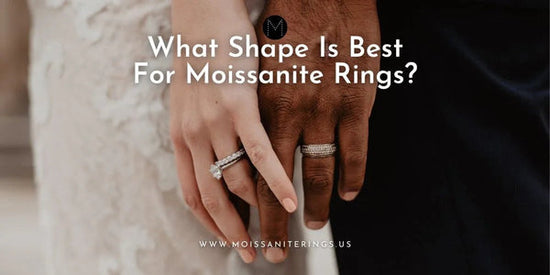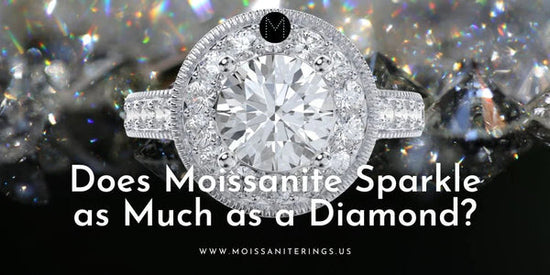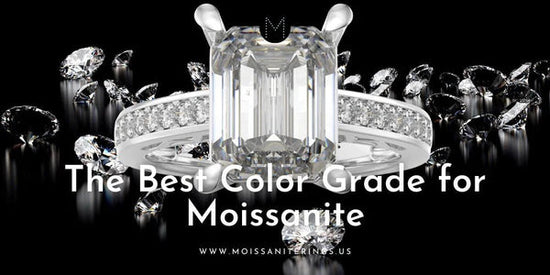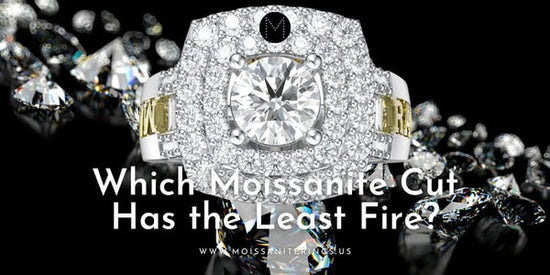What Stone Sparkles Like a Diamond?

Contents
Diamonds are known for their exceptional beauty and sparkling radiance. However, other stones can also sparkle, like diamonds. These stones include cubic zirconia, white sapphire, and moissanite. Each of these stones has unique characteristics and is prized for its reasons. This article will explore these stones and compare them to diamonds to see what makes them shine.

Introduction
A diamond's sparkle, also known as its "fire," is caused by how light is reflected, refracted, and dispersed within the gemstone. Diamonds have a high refractive index, which means they are particularly good at bending light as it passes through the stone. As a result, diamonds can break up white light into its constituent colors, creating a rainbow-like effect known as dispersion.
This sparkle is one of the main reasons diamonds are so highly sought after in jewelry. It is a symbol of beauty, luxury, and love and has been prized by cultures worldwide for centuries.
However, only some can afford or wish to buy a diamond. As a result, several alternatives to diamonds are available on the market. These alternatives, known as diamond simulants or diamond substitutes, are materials designed to mimic a diamond's appearance. Some examples of diamond simulants include cubic zirconia, moissanite, and white sapphire. These simulants are often less expensive than diamonds. They are more readily available, making them an attractive option for those who want the look of a diamond without the cost.

Cubic Zirconia
What is Cubic Zirconia?
Cubic zirconia, or CZ, is a synthetic gemstone made from zirconium oxide and yttrium oxide. It is colorless, complex, and optically flawless, which makes it an attractive diamond alternative for those who want a sparkling, shiny gemstone without the cost of a diamond.
Pros and Cons of Cubic Zirconia
Pros:
ProsCost: One of the main advantages of cubic zirconia is that it is significantly less expensive than diamonds. This makes it an attractive option for those who want the look of a diamond without the high price tag.
Durability: Cubic zirconia is generally more durable than diamond simulants, such as glass or plastic. It is resistant to breaking and chipping and can withstand daily wear and tear.
Availability: Cubic zirconia is widely available in various sizes, shapes, and cuts, making it easy to find the perfect gemstone for any occasion.
Cons:
Hardness: Cubic zirconia is more durable than some other diamond simulants but is not as hard as diamonds. Diamonds have a Mohs scale rating of 10, while cubic zirconia has a rating of 8.5-9. Cubic zirconia may be more prone to scratching and can be damaged more easily than diamonds.
Brilliance: Diamonds are known for their exceptional luster and fire caused by their high refractive index and ability to disperse light. While cubic zirconia can also refract light and create a similar rainbow-like effect, it does not have the same brilliance as diamonds. Some people can tell the difference between the two stones.
Authenticity: Cubic zirconia is a synthetic gemstone created in a lab setting, while diamonds are naturally occurring gemstones. For some people, the fact that cubic zirconia is not a natural diamond may be a disadvantage.
Cubic zirconia is often considered the closest diamond simulant in terms of sparkle. It can refract light in a way that is similar to diamonds, and it can create a rainbow-like effect known as dispersion. However, it is essential to note that cubic zirconia is not a genuine diamond and does not have the same level of brilliance or fire as a natural diamond.

Moissanite
What is Moissanite?
Moissanite is a synthetic gemstone that is made from silicon carbide. It was discovered in a meteorite by Henri Moissan in 1893. Still, it is now produced in a lab setting. Moissanite is known for its unique sparkle and fire caused by its high refractive index and dispersive power. It is also tough and durable, making it a popular choice for jewelry.
Pros and Cons of Moissanite
Pros:
- Durability: Moissanite is a challenging and durable gemstone with a Mohs scale rating of 9.25-9.5. This makes it resistant to breaking and chipping and can withstand daily wear and tear.
- Brilliance: Moissanite is known for its unique sparkle and fire caused by its high refractive index and ability to disperse light. It can refract light in a way that is similar to diamonds, creating a rainbow-like effect.
- Cost: Moissanite is generally less expensive than diamonds, making it an attractive option for those who want the look of a diamond without the high price tag.
Cons:
- Authenticity: Like cubic zirconia, moissanite is a synthetic gemstone created in a lab setting rather than naturally occurring gemstones like diamonds. This may be a disadvantage for some people who prefer natural gemstones.
- Availability: Moissanite is less widely available than other diamond simulants, such as cubic zirconia. This may make finding moissanite in specific sizes, shapes, and cuts more challenging.
- Brilliance: While moissanite is known for its sparkle and fire, it is not as brilliant as diamonds. Some people can tell the difference between the two stones, especially when the stones are compared side by side.

White Sapphire
What is White Sapphire?
White sapphire is a type of sapphire found in various locations worldwide, including in Madagascar, Australia, and Thailand. It is a gemstone known for its durability, clarity, and brightness. White sapphire is typically colorless, but it can also be found in shades of yellow, green, pink, and orange.
Pros and Cons of White Sapphire
Pros:
- Durability: White sapphire is a challenging and durable gemstone with a Mohs scale rating of 9. It is resistant to breaking and chipping and can withstand daily wear and tear.
- Clarity: White sapphire is known for its clarity and brightness, which makes it an attractive gemstone for jewelry. It is typically colorless but can also be found in shades of yellow, green, pink, and orange.
- Cost: White sapphire is generally less expensive than diamonds, making it a more affordable alternative for those who want the look of a diamond without the high price tag.
Cons:
- Authenticity: Like cubic zirconia and moissanite, white sapphire is a naturally occurring gemstone, but it is not a diamond. For some people, the fact that white sapphire is not a natural diamond may be a disadvantage.
- Brilliance: While white sapphire is known for its clarity and brightness, it is not as brilliant as diamonds. Some people can tell the difference between the two stones, especially when the stones are compared side by side.
- Availability: White sapphire is not as widely available as other diamond simulants, such as cubic zirconia. This may make finding white sapphires in specific sizes, shapes, and cuts more challenging.

Comparison of Diamond Alternatives
Sparkle and Overall Appearance
In terms of sparkle and overall appearance, all three of these diamond alternatives - cubic zirconia, moissanite, and white sapphire - can somewhat mimic the look of a diamond. However, it is essential to note that none of these simulants can completely replicate the face of a natural diamond. Diamonds have a level of brilliance and fire that is unmatched by other gemstones, giving them their unique sparkle. While cubic zirconia, moissanite, and white sapphire can refract and disperse light in a way similar to diamonds, they do not have the same level of sparkle and overall appearance.
Price Comparison
In terms of price, all three of these diamond alternatives are significantly less expensive than diamonds. Cubic zirconia is generally the least costly of the three, followed by white sapphire, with moissanite being the most expensive. However, it is essential to note that the price of these simulants can vary widely depending on the size, quality, and cut of the stone.

Conclusion
In conclusion, we have discussed diamond alternatives and looked at three specific simulants: cubic zirconia, moissanite, and white sapphire. We have compared the sparkle and overall appearance of these simulants to diamonds. We have discussed the pros and cons of each option.
It is important to remember that each diamond alternative has unique properties and characteristics, and it is essential to consider them before making a decision. While cubic zirconia is the least expensive option, diamond is more brutal and brilliant. Moissanite is a more expensive option, but it is challenging and has a unique sparkle. White sapphire is also a durable option, but it is not as widely available as the other stimulants.
When considering a diamond alternative, it is essential to research your personal preferences. What is most important to you - cost, durability, sparkle, or something else? You can choose the best diamond alternative for your needs by taking the time to think about these factors. So, it is always better to do some research before making a decision.
If you are interested in purchasing a moissanite engagement ring, visit MoissaniteRings.US. We offer a wide selection of moissanite rings at affordable prices, and our expert jewelers can help you find the perfect ring to suit your style and budget. So, why wait? Head to MoissaniteRings.US today and browse our selection of beautiful moissanite engagement rings.
Recommended reading:
Moissanite vs Diamond: The Ultimate Guide
Does Moissanite Sparkle as Much as a Diamond?
Is Moissanite as Good as a Diamond?
What Lasts Longer: Moissanite or Diamond?
Is it Better to Buy a Diamond or Moissanite?
What Stone Sparkles Like a Diamond?
Will Moissanite Pass a Diamond Tester?
Moissanite Carat Size Vs. Diamond: Moissanite Win
Cubic Zirconia vs. Moissanite vs. Diamond: A Comprehensive Guide
Is cubic zirconia or Moissanite better?
Are Moissanite Diamonds Worth Anything?











